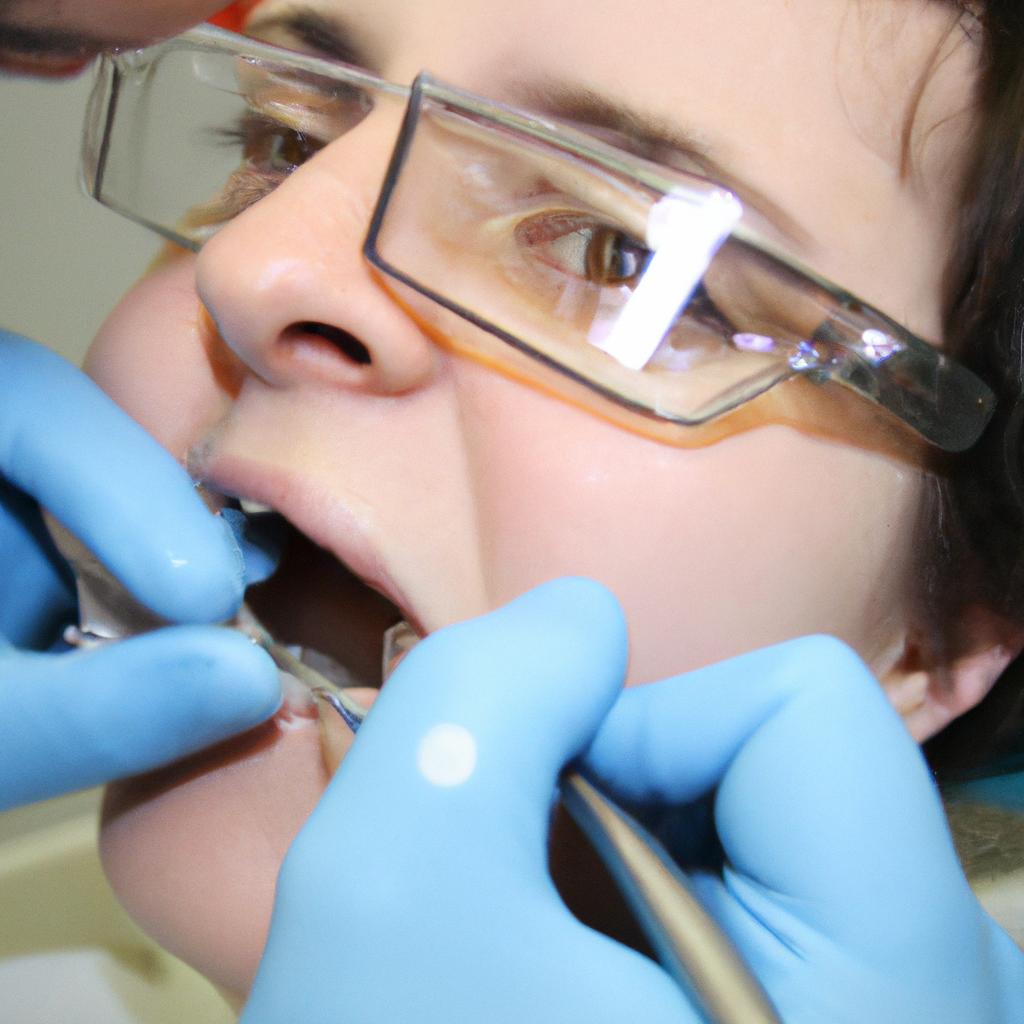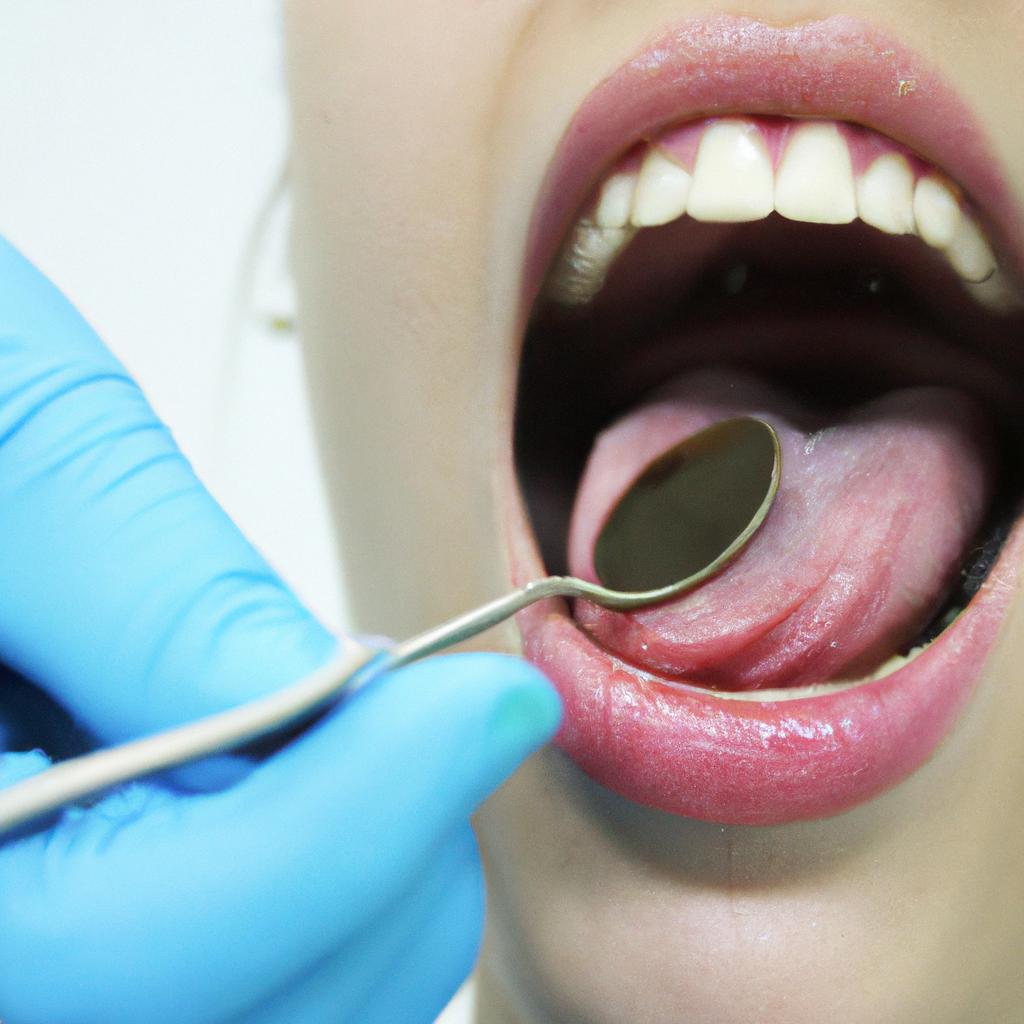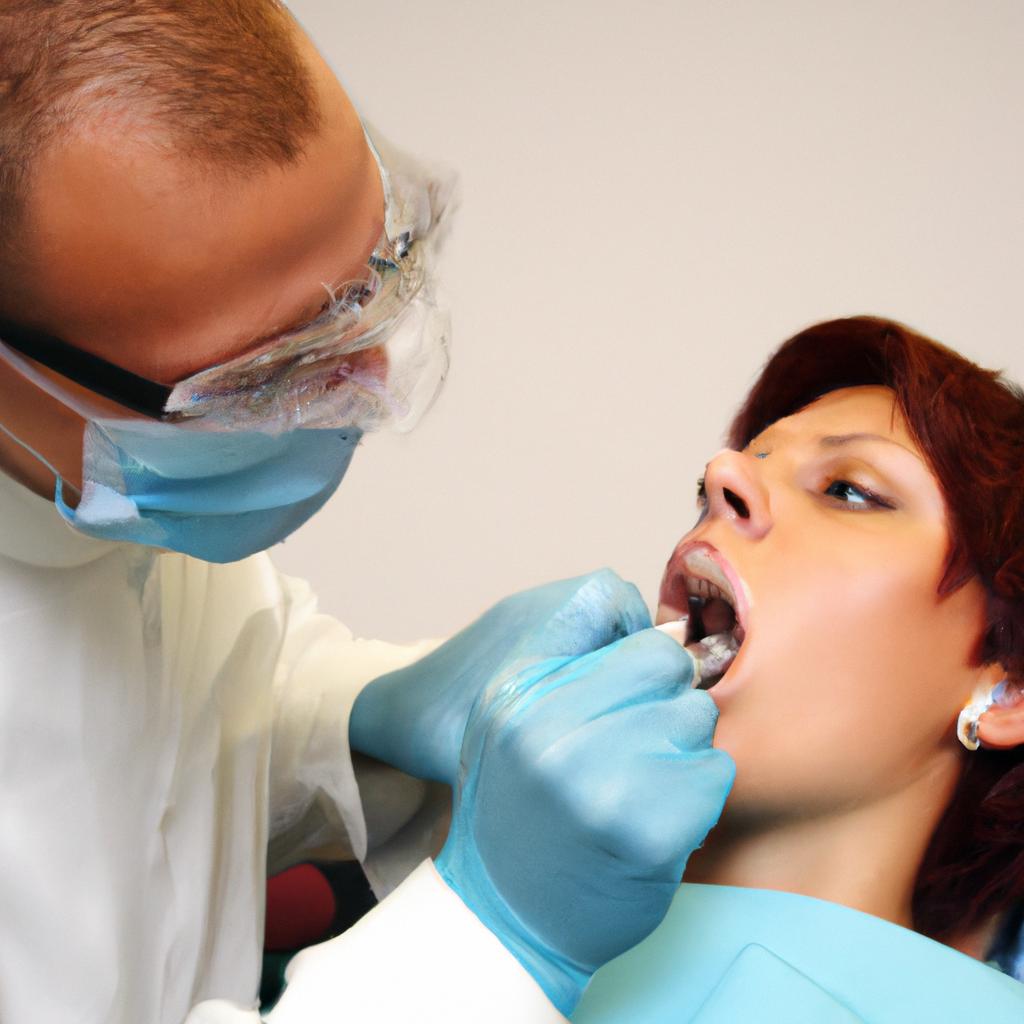Gingivitis: A Comprehensive Guide in Periodontics

Gingivitis, a common oral health condition characterized by inflammation of the gums, is often overlooked but should not be underestimated in its potential impact on overall periodontal health. This comprehensive guide aims to provide an academic exploration of gingivitis and its significance within the field of periodontics. By examining various aspects such as etiology, clinical manifestations, and treatment options, this article seeks to enhance understanding and awareness regarding this prevalent dental concern.
To illustrate the importance of addressing gingivitis promptly and effectively, let us consider a hypothetical case study. Imagine a middle-aged individual who has been neglecting their oral hygiene routine for several years due to busy work schedules and personal commitments. As time goes by, they begin to notice that their gums appear swollen, red, and bleed easily when brushing or flossing. Ignoring these early signs of gingival inflammation could lead to further progression of the disease process. Thus, recognizing the relevance of proper management becomes crucial in preventing more severe complications such as periodontitis or tooth loss.
Overview of Gingivitis
Gingivitis, a common gum disease characterized by inflammation and swelling of the gums, affects individuals of all ages worldwide. One example illustrating the impact of gingivitis is that of Mr. Smith, a 45-year-old patient who presented to the dental clinic complaining of bleeding gums during brushing and flossing. Upon examination, his dentist diagnosed him with mild gingivitis due to poor oral hygiene practices.
To better understand this condition, it is important to explore its causes, symptoms, and potential consequences. The following bullet point list highlights key aspects related to gingivitis:
- Redness and Swelling: Inflammation leads to visible signs such as redness and swelling in the gums.
- Bleeding Gums: Frequent bleeding while brushing or flossing may indicate the presence of gingivitis.
- Bad Breath: Persistent bad breath (halitosis) can be a result of bacterial growth associated with gum disease.
- Sensitive Gums: Gingivitis often causes sensitivity in the gums, making them tender or painful when touched.
Additionally, understanding how gingivitis progresses can provide valuable insight into preventing further deterioration. Consider the table below outlining different stages of gum disease based on severity:
| Stage | Description |
|---|---|
| Stage 1: | Mild gingivitis – early stage characterized by slight inflammation and occasional bleeding |
| Stage 2: | Moderate gingivitis – increased inflammation leading to more frequent bleeding |
| Stage 3: | Advanced gingivitis – significant inflammation accompanied by persistent bleeding |
| Stage 4: | Severe periodontal disease – irreversible damage including tooth loss |
By recognizing these stages, individuals can take appropriate measures at an earlier phase to prevent worsening conditions.
Transitioning into the subsequent section about “Causes and Risk Factors,” it is crucial to delve deeper into the underlying reasons behind gingivitis. Understanding these factors will shed light on effective prevention strategies and treatment options for individuals at risk of developing or already experiencing this gum disease.
Causes and Risk Factors
In the previous section, we explored an overview of gingivitis, its definition, and how it is diagnosed. Now, let’s delve into the causes and risk factors associated with this common periodontal disease.
Causes:
Gingivitis often occurs due to poor oral hygiene practices. When plaque builds up on teeth and along the gumline, bacteria thrive in this environment, leading to inflammation of the gums. One example that illustrates this is a case study involving a 35-year-old individual who neglected their dental care routine for several months. As a result, they developed gingivitis characterized by redness, swelling, and bleeding gums.
Risk Factors:
Several factors contribute to an increased susceptibility to gingivitis. These include:
- Inadequate oral hygiene: Failing to brush or floss regularly allows plaque buildup.
- Hormonal changes: Pregnancy or hormonal imbalances can make gums more sensitive and prone to inflammation.
- Diabetes: Poorly controlled blood sugar levels can impair immune function and increase the risk of gum diseases.
- Smoking: Tobacco use weakens the body’s ability to fight off infections and slows down healing processes.
- Neglected oral hygiene
- Hormonal changes during pregnancy
- Uncontrolled diabetes
- Regular smoking or tobacco use
Now let’s examine a table that presents some statistics related to gingivitis prevalence among different age groups:
| Age Group | Prevalence (%) |
|---|---|
| 20 – 39 | 45 |
| 40 – 59 | 70 |
| 60+ | 90 |
The data above clearly shows that as age increases, so does the likelihood of developing gingivitis. This information can evoke concern among readers about the potential risks they face if preventive measures are not taken.
Understanding the causes and risk factors associated with gingivitis is essential in developing effective prevention and treatment strategies. In the upcoming section, we will explore the signs and symptoms that can help identify this condition early on. By recognizing these indicators, individuals can take prompt action to maintain their oral health and prevent further complications.
Signs and Symptoms
Gingivitis, a common gum disease characterized by inflammation of the gingiva, can be caused by various factors. Understanding these causes and risk factors is crucial in preventing and managing this condition effectively.
One example that highlights the impact of certain factors on the development of gingivitis involves an individual named Sarah. Sarah had a habit of poor oral hygiene practices, including irregular brushing and infrequent dental visits. Additionally, she was a smoker for several years. Due to her negligent approach towards oral care and exposure to tobacco smoke, Sarah developed chronic gingivitis which required immediate intervention from dental professionals.
To further comprehend the causes and risk factors associated with gingivitis, consider the following:
- Poor oral hygiene: Inadequate removal of plaque buildup due to improper toothbrushing techniques or neglecting regular flossing promotes bacterial growth, leading to gingival inflammation.
- Smoking: Tobacco use weakens the immune response within the gums and reduces blood flow to periodontal tissues, increasing susceptibility to infection.
- Hormonal changes: Fluctuations in hormone levels during puberty, pregnancy, or menopause can cause increased sensitivity and vulnerability of gum tissue.
- Diabetes: Individuals with diabetes are more prone to developing infections throughout their body, including gum disease.
An emotional connection can be established through a bullet point list highlighting some consequences of untreated gingivitis:
- Persistent bad breath
- Receding gums leading to tooth sensitivity
- Prolonged bleeding during brushing or flossing
- Tooth loss if left untreated
Furthermore, here is a table displaying potential complications related to advanced stages of untreated gingivitis:
| Complication | Description |
|---|---|
| Periodontitis | Severe form of gum disease where infection spreads below the gum line |
| Dental abscess | Accumulation of pus resulting from an infected tooth |
| Cardiovascular diseases | Increased risk of heart disease and stroke |
| Respiratory infections | Inhaled bacteria from the mouth can lead to respiratory problems |
Understanding the causes, risk factors, and potential consequences of gingivitis emphasizes the importance of early intervention and proper oral hygiene practices. By addressing these aspects, individuals can significantly reduce their susceptibility to gum disease.
With a comprehensive understanding of the causes and risks associated with gingivitis, it is essential to explore its signs and symptoms in order to facilitate prompt diagnosis and evaluation.
Diagnosis and Evaluation
Gingivitis, a common periodontal disease characterized by inflammation of the gums, can often go unnoticed in its early stages. However, being aware of its signs and symptoms is crucial for timely diagnosis and intervention. By paying attention to these indicators, individuals can take proactive steps towards managing their oral health effectively.
For instance, let us consider a hypothetical case study: Sarah, a 35-year-old woman who has been experiencing bleeding gums while brushing her teeth for the past few weeks. This serves as an initial warning sign since healthy gums typically do not bleed during routine oral hygiene practices. In addition to this hallmark symptom, other common manifestations of gingivitis include redness or swelling of the gum tissue, tenderness or pain in the affected area, persistent bad breath (halitosis), and receding gum line.
To further understand the various signs and symptoms associated with gingivitis, consider the following bullet points:
- Bleeding gums: One of the earliest indications of gingivitis that occurs due to plaque buildup along the gumline.
- Gum discoloration: Gums may appear redder than usual due to increased blood flow caused by inflammation.
- Gum recession: As gingivitis progresses, there may be noticeable shrinkage of the gum tissue leading to exposure of tooth roots.
- Bad breath: The accumulation of bacteria in infected pockets within the gums can result in persistent foul odor.
The table below provides a visual representation of additional signs commonly observed in individuals with gingivitis:
| Signs | Description |
|---|---|
| Swollen gums | The gum tissue becomes enlarged and puffy. |
| Sensitive teeth | Teeth may become more sensitive to hot or cold stimuli. |
| Loose teeth | Severely advanced cases may cause tooth mobility. |
| Pus between teeth | A yellowish discharge may be present due to infection. |
Recognizing and addressing these signs and symptoms promptly is key in preventing the progression of gingivitis into more severe forms of periodontal disease. By seeking professional dental care, individuals can receive an accurate diagnosis and evaluation of their condition.
In the subsequent section about “Diagnosis and Evaluation,” we will delve deeper into the methods used by dental professionals to assess gingivitis and determine appropriate treatment options for patients.
Treatment Options
Building upon the diagnostic process, this section will delve into the available treatment options for individuals diagnosed with gingivitis. By addressing the underlying causes and employing appropriate interventions, clinicians can effectively manage and mitigate the progression of this periodontal condition.
When developing a treatment plan for patients with gingivitis, dental professionals consider various factors such as the severity of inflammation, individual patient needs, and desired outcomes. One example is a case study involving a 35-year-old male presenting with red, swollen gums exhibiting bleeding during brushing and flossing. After an initial examination and assessment, it was determined that his oral hygiene practices were suboptimal, leading to plaque accumulation and subsequent gingival inflammation.
To address gingivitis effectively, several essential treatment options are commonly employed:
-
Oral Hygiene Education: Educating patients about proper oral hygiene techniques plays a pivotal role in preventing further disease progression. This includes instructions on effective toothbrushing methods (such as the modified Bass technique) and regular interdental cleaning practices like flossing or using interdental brushes.
-
Professional Dental Cleaning: Scaling and root planing procedures performed by dental hygienists or dentists remove calculus deposits from tooth surfaces above and below the gumline. This step helps eliminate bacterial biofilm associated with gingivitis while promoting healing of inflamed tissues.
-
Antimicrobial Therapy: Adjunctive use of antimicrobial agents may be recommended to reduce bacterial load and control infection in severe cases of gingivitis. These treatments can include mouth rinses containing chlorhexidine gluconate or antibiotic gels applied topically to affected areas.
-
Lifestyle Modifications: Encouraging positive lifestyle changes can significantly contribute to managing gingivitis symptoms. Quitting tobacco use, maintaining a healthy diet rich in fruits and vegetables, limiting sugary snacks and beverages, along with stress management techniques all support overall oral health.
- Improved oral hygiene practices can lead to healthier gums and fresher breath.
- Early intervention and treatment of gingivitis can prevent more severe forms of periodontal disease.
- Regular dental cleanings reduce the risk of tooth loss and improve overall oral health.
- By actively participating in their treatment plan, individuals with gingivitis regain control over their oral health.
| Treatment Options | Benefits | Considerations |
|---|---|---|
| Oral Hygiene Education | Promotes proper technique | Requires patient compliance |
| Professional Dental Cleaning | Removes calculus deposits | May cause temporary sensitivity |
| Antimicrobial Therapy | Reduces bacterial load | Potential staining or taste alteration |
| Lifestyle Modifications | Supports overall oral health | Requires behavior change commitment |
Looking ahead, the subsequent section will focus on preventive measures and maintenance strategies aimed at minimizing the recurrence of gingivitis.
Prevention and Maintenance
Transitioning from the previous section on treatment options, it is crucial to explore effective strategies for preventing gingivitis and maintaining good oral health. By implementing preventive measures, individuals can significantly reduce their risk of developing this common periodontal condition.
Imagine a hypothetical scenario where Sarah, a regular dental patient, follows proper oral hygiene practices but still experiences recurring episodes of gingivitis. This case highlights the importance of prevention and maintenance techniques beyond basic brushing and flossing.
Prevention and maintenance play integral roles in managing gingivitis effectively. Here are some key strategies that individuals should consider:
- Regular Dental Check-Ups:
- Routine visits to the dentist help identify early signs of gum disease.
- Proper Oral Hygiene:
- Brushing teeth at least twice daily with fluoride toothpaste.
- Flossing between teeth to remove plaque buildup.
- Using mouthwash to control bacteria growth.
- Balanced Diet:
- Consuming a nutritious diet rich in vitamins and minerals supports healthy gums.
- Avoidance of Tobacco Products:
- Smoking or chewing tobacco increases the risk of gum disease.
The Emotional Impact of Poor Gingivitis Management
- Social discomfort due to bad breath or visible inflammation
- Reduced self-esteem affecting personal relationships
- Increased anxiety about potential tooth loss
- Financial burden caused by extensive treatments
Furthermore, let’s present information using a table format that showcases different factors contributing to gingivitis development:
| Risk Factors | Effects | Preventive Measures |
|---|---|---|
| Poor Oral Hygiene | Plaque accumulation | Establish consistent brushing/flossing routine |
| Hormonal Changes | Increased sensitivity and inflammation | Maintain good oral hygiene practices |
| Smoking/Chewing Tobacco | Impaired blood flow to gums | Quit smoking/chewing tobacco |
| Diabetes | Reduced ability to fight infections | Regular dental check-ups and glucose control |
In summary, prevention and maintenance are fundamental in the management of gingivitis. By following proper oral care routines, attending regular dental check-ups, adopting a well-balanced diet, and avoiding harmful habits such as smoking or chewing tobacco, individuals can significantly reduce their risk of developing this periodontal condition. Recognizing the emotional impact that poor gingivitis management may have on one’s social life, self-esteem, anxiety levels, and finances serves as an additional motivation to prioritize preventive measures.





